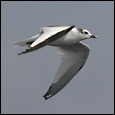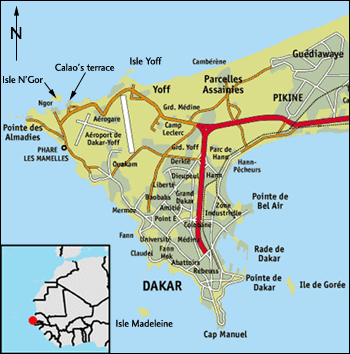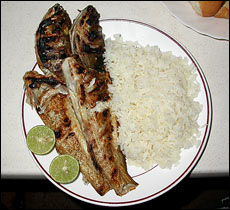
 |
| The westernmost tip of the Cap Vert peninsula
and whole Africa as well: Pointe des Almadies (seen from north). Photo: Niklas Holmström, 2005 |
Senegal is in the
extreme west of the African continent, at the edge of the Atlantic Ocean.
It is a country of the Sahel, primarily flat, and bordered on the north
by Mauritania, the east by Mali, the south by Guinea-Bissau, and completely
surrounding the tiny Gambia in the centre. Senegal lies at a latitude
of between 12° and 17° north of the equator. The large Cap Vert
peninsula juts out about five miles west into the Atlantic ocean. The
capital city Dakar is located at the end of the peninsula. A further 50
miles west, in the ocean, lies the Cape Verde Islands.
On 20th June 1960, Senegal and Mali became completely
independent from France, while remaining within the French union. But
two months later the Senegal-Mali union broke up and the French West Africa
had become nine separate republics.
If you plan to visit Senegal or Gambia, then Lonely
Planet's guide book 'The Gambia and Senegal' is as an essential piece
of kit as binoculars and telescope!
 |
|
| The map is modified and updated by Martin Åkesson, Sweden. |
Here you will find a nice and resizeable satellite map of the area along with notes and linked photos, specially addressed to birders. The map, modified by Björn Johansson, also show where important or interesting places are located. Just click on the symbols directly in the map or use the links int he left menu.
Climate
and clothing
The dry season is between September and May on the Cap Vert peninsula
and is dominated by the hot and dry harmattan wind. The temperature in
October to November often rises above 30°C in the day and stays just
below in the nights. The humidity is relatively high. So the cooling effect
of the winds along the coast is a welcome delight when you are seawatching
(and perhaps sending a thankful thought of not being stuck in the warm,
African interior!). Other clothes than a T-shirt/shirt and shorts/thin
trousers and, of course, a sunhat are not required. A waterproof jacket
is recommended on pelagic tours, to stay dry from water sprays when travelling
in open boats in high speed.
During the best seawatching period (in autumn), the
sun rises at 07:00 and sets at about 18:50, which makes it possible to
seawatch for about 11 hours, but a break around 12.00 to 14.00 are recommended
because of the heat haze. For more information about the weather at Dakar
(5 day forecast, current conditions, weather history and much more) please
have a look at the useful web site 'Weather
Underground'.
Health
Vaccinations
Plan ahead for getting your vaccinations: Some of them require more than
one injection, while some should not be given together. Note that some
vaccinations should not be given to people with allergies – consult
your doctor. Make sure that you have adequate health insurance.
Malaria
This serious and potentially fatal disease is spread by mosquito bites
and exists year round throughout the country. No place in Senegal is completely
free from malaria so it is extremely important to avoid mosquito bites
and to take tablets to prevent the disease, especially if you are heading
out of Dakar.
Water
The water in Senegal's main cities is generally clean, but be careful
and especially avoid ice. To be on the safe side, stick to bottled water.
Its recommended to drink 3-5 litres of water a day and it cannot be said
too often: Don't forget to drink lots of water!
For further information
about health tips for Senegal see Travelers'
Health»
Currency
The currency unit of Senegal is the CFA Franc (simply called 'seefa')
which is tied to the EURO. One good advice is to exchange some money of
your currency into CFA before your visit Senegal and only demand bills
in 1.000, 5.000 and 10.000. Remember that if you only use Euro as a currency
to pay items the rate to the CFA are lower (1 Euro = CFA 630 is the most
common rate). You will soon discover that many places, the boat to Isle
N'Gor for example, for some reason cannot change money (not even CFA)
or bills of a higher denomination than 5.000. So, always try to have a
bundle of 500 and 1.000 CFA bills ready in your pocket. Use Euro or credit
card to pay pelagic trips and accommodation with.
Today (22 October 2008) the rates are 1 Euro = CFA 641.
You can calculate the value of the CFA in Euro with the Yahoo
currency converter»
To calculate the value of the EURO in your currency unit (British pounds,
American dollars etc) you can use the calculator of the X-RATES web site:
www.x-rates.com/calculator.html
Credit and Debit
cards
You can use credit cards to pay for some items, but their use is usually
limited to mid-range and top-end hotels, restaurants and car rental. Visa
and American Express (AmEx) are the most widely accepted, but MasterCard
can also be used. You can use a credit card to draw cash at banks in the
major cities or in places used to handling tourists.
Banks and card companies often charge fair exchange
rates, which can make drawing money from the ATMs cheaper than changing
travellers cheques. At N'Gor there is one ATM in the same building as
the Select and petrol station close to the hotel area (about 10 minutes
walk from Calao).
Food
By West African standards Senegal is a veritable culinary paradise. In
the N'Gor area (and on Isle N'Gor) there are many restaurants with excellent
food, especially when it comes to seafood. For hungry seawatchers/birders
there are two restaurants with both delicious food and perfect conditions
for birding: L'Oasis on Isle N'Gor where you can see gulls and terns passing
through the strait and the ultimate seawatching spot at Club le Calao's
restaurant terrace (see the section 'Seawatching').
Price examples (of our favourite dishes in October 2007)
at Club le Calao's restaurant which facing the sea:
 |
| A
very tasty fish dinner at Calao! Photo: Martin Oomen, 2005 |
Fish
Filet Lot: 4.500 CFA (for all dishes you could chose between rice or chips)
Brochette de Poisson: 4.000 CFA
Filet de Capitaine: 4.500 CFA
Sole Meunière: 4.500 CFA
Meat
Emincé de Boeuf á L'orientale: 5.000 CFA
Filet de Boeuf au Poivre Vert: 5.000 CFA
Chicken
Poulet grillé à L'ail: 4.500 CFA
Lunch food
Different omelettes: between 1.500-3.000 CFA
Baguette with ham and cheese: 2.000 CFA
Drinks
Half litre of red wine: 2.500 CFA
Beer (Flag): 1.000 CFA (600 on Isle N'Gor)
Espresso: 1.000 CFA
Brief facts about
Senegal
Area: 196,190 square kilometres (land; 192,000 sq km, water; 4,190
sq km)
Coastline: 531 km
Population: 10,5 million
Capital city: Dakar (population; 2 million)
People: Wolof (36%), Fulani (17%), Sérèr (17%), Toucouleur
(9%), Diola (9%), Mandingo (9%), European and Lebanese (1%).
Languages: French (official), Wolof, Pulaar, Diola and Mandingo.
English is used daily in commerce and international trade, but you will
find out that French is the most useful language. However, with patience
and time you will soon reach an agreement even if you do not speak French.
Religion: 94% Islam, 1% indiginous beliefs and 5% Christian.
Government: Republic under multi-party democratic rule.
President: Aboulaye Wade
Visas: Visas are not needed by citizens of the European Union,
Canada, Norway, South Africa, Japan, Israel, USA and several other African
countries.
Electricity: 220V. Plugs as in Scandinavia and continental Europe
with two round pins.
Copyright © 2004-2012, All rights reserved